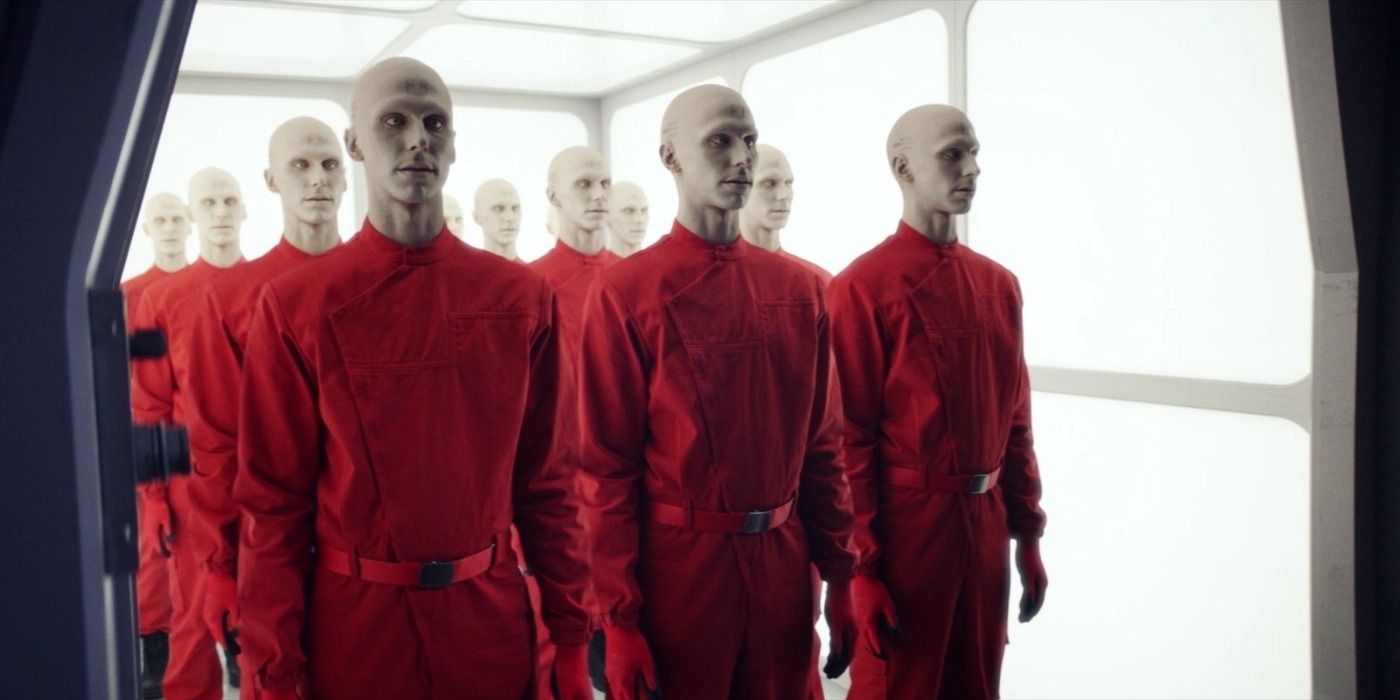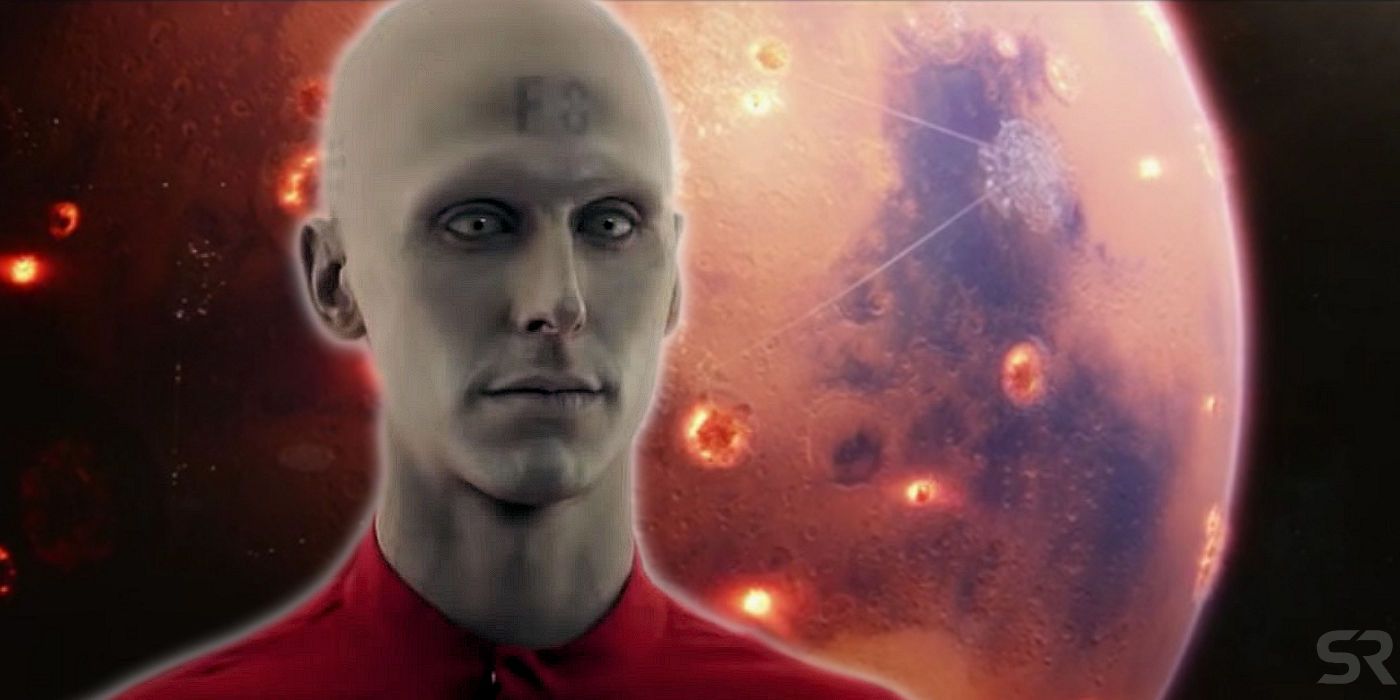Warning: contains spoilers for “Go See Cal,” appearing in Star Trek #500!
Star Trek: Lower Decks just introduced its impressive, but twisted, version of Data. The android Data is one of the Star Trek franchise’s most compelling characters, but outside his brothers Lore and B4, he is one of a kind. Yet in the story “Go See Cal,” appearing in Star Trek #500, Rutherford, the engineering whiz of the Cerritos, creates his own riff on Data, carrying some heavy implications.
“Go See Cal” is one of the many stories appearing in the Star Trek #500 anthology. The story, written by Magdalene Visaggio and drawn by Megan Huang, opens with Tindi and Rutherford having assembled their own Soong-type android, revealing that every cyberneticist in the Federation is trying the same thing. Rutherford reveals he uses a black market “bi-neural compensator” obtained from a Ferengi. As a result, this Data variant seeks nothing but profit and advocates capitalism. After nearly auctioning the ship and crew off, Rutherford and Tendi reluctantly deactivate him.
Data Is a Quintessential Star Trek Character
Data Is One of a Kind in the Star Trek Franchise
Data, played by Brent Spiner, has been one of the Star Trek franchise’s most popular characters. Fans responded to Data’s desire to better understand the human experience, and maybe even become one himself eventually. Data was built by the brilliant, but reclusive cyberneticist Doctor Noonian Soong. Data was the third such model built: B4 was the first and Lore the second. Lore rebelled, and would become one of Star Trek’s greatest villains, and will soon threaten all creation in the forthcoming Lore War. B4 was seen only once, in Star Trek: Nemesis, and has not been heard from since.
Star Trek has repeatedly stressed Data’s highly unique nature–there is no one else in the galaxy quite like him, apart from his brothers. Data’s creator, Noonian Soong, was one of the galaxy’s most refined scientific minds. Descended from a line of gifted inventors and scientists, Noonian Soong was able to do the impossible: build a positronic brain. Data’s one of a kind nature made him known throughout the Federation, and as seen in the sixth season Next Generation episode “The Chase,” the Klingon Empire as well. Data has been coveted by enemy empires and overzealous collectors alike.
Data Tried to Duplicate Himself Once–It Did Not Go Well
Data’s Attempt to “Procreate” Was One of His Harshest Lessons
As part of Data’s desire to better understand humanity, he created another Soong-model android, who he named “Lal.” As seen in the third season Next Generation episode “The Offspring,” Data wished to know what it was like to be a father, and Lal was going to be how he would do it. Lal became popular with the crew, but drew the ire of Starfleet Command. Incensed that Data would create life without consulting anyone, Starfleet dispatched an expert in robotics and cybernetics to assess the situation. During his visit, Lal’s positronic matrix begins to break down, forcing Data to terminate her program.
Lal was played in “The Offspring” by actress Hallie Todd.
The finale of “The Offspring” is one of the most gut-wrenching moments in the history of Star Trek: The Next Generation. It represented a failure on Data’s part, and stressed just how cutting edge, and ahead of its time, Noonian Soong’s work was. None of the Federation’s best minds, to that point, had been able to duplicate Soong’s magic. Soong’s work was so far advanced that not even his own “children” could recreate it. Data came as close as anyone ever had in “The Offspring,” but even he met with a dead end.
The Federation Has A Mixed Attitude Towards Synthetic Life
Soong-Style Androids Nearly Brought the Federation To Its Knees
A seemingly throwaway reference in “Go See Cal” also sheds light on the state of cybernetics and robotics research in the Federation. Captain Freeman, Rutherford’s commanding officer, mentions an “All Fleet Robotics Prize,” and that many in Starfleet are attempting to build a Soong model android. The events of “Go See Cal” are set roughly a decade after the events of “The Offspring,” meaning there have been significant advances in technology since Data built Lal. That Starfleet holds a Robotics contest in the first place speaks volumes as to how the technology is viewed.
Soong-model androids would play big roles in the latter half of the 24th century. Eventually, the Federation seemingly “cracked the code” of Soong, creating an army of Data-like androids, which came to be called “synths.” On First Contact Day in 2385, a synth appeared to go rogue, initiating an attack on Mars that killed close to 100,000 people and destroyed many starships. In the wake of the tragedy, an investigation concluded that a “programming error” in the synths led to the attack, and as a result, placed a ban on research into the area.
The synths were not culpable in the attack, however. It was revealed that a renegade faction of the Romulan Tal Shiar, called the Zhat Vash, instigated the attack. The Zhat Vash believed that synthetic life was an existential threat to the galaxy, and were willing to kill not only thousands of Federation citizens, but their own people as well. Once this came to light, the ban was lifted and research began into the field again. The events of “Go See Cal” take place shortly before the Attack on Mars, and the crew’s attitudes towards synthetic life reflect this.
The Attack on Mars Fundamentally Changed Both the Federation and Synths
Rutherford Makes a Name for Himself in the Star Trek Universe
The Attack on Mars would no doubt have impacted the All-Fleet Robotics Prize. In the pursuit of it, Rutherford built an android that nearly equaled anything Noonian Soong created. If Rutherford had not used an illicit part, he might have succeeded in duplicating Soong’s achievements. Like Soong, Rutherford himself is no stranger to creating technology that runs amok: Badgey, the murderous AI, was built by Rutherford, a fact he alludes to in “Go See Cal.” Yet, after the Attack on Mars, the Prize, and all research, was more than likely mothballed.
“Go See Cal” puts a Star Trek: Lower Decks-type spin on episodes such as “The Offspring,” as well as the Federation’s evolving attitudes towards synthetic life. Doctor Soong’s research into the field was light years ahead of the Federation’s best scientific minds. Others have had trouble duplicating Soong’s results, but this has not stopped the Federation and Starfleet from trying. Rutherford, one of Starfleet’s most promising young engineers, has proven himself worthy of Noonian Soong, helping create a new, but darker, version of Data.
Star Trek #500 is on sale now from IDW Publishing.





